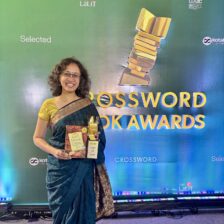During the first two weeks of the year, I made lists of books I loved, and more than once, I found myself writing about how reading levels differ so much that it is difficult to associate a level with an age. Thinking about all of this, I decided write about a reading programme I’ve been working with for a couple of years now.
Two years ago, I was approached by Experiential Learning Solutions and asked whether I would design a reading programme that can be administered effectively by a group of librarians in municipal schools. As a CSR initiative, D-Mart had invested in eleven libraries for schools and eleven librarians, but they wanted to go beyond that. They wanted to ensure the success of their library programme in the form of children taking a step towards reading.

What could we do to get children to read? How could we surmount huge obstacles, including the indifference of teachers and irregularity of students?
I put together a structure and we began work. That’s when I came across obstacles that I knew existed, but had never really encountered myself because we do all live in our little bubbles.
A few of the problems we addressed …
One, children come from multiple backgrounds. For instance, in a predominantly Hindi-speaking area, children attend a school where the medium of instruction is Marathi. “In my class of forty, in a Marathi medium school, only five children speak Marathi,” one librarian said to me.
Two, every class has widely different reading levels. “The children who have been with us for some time are okay, on the whole, but new children come in all the time. And if a child is ten years old, he is put into class five, even if he has not even learnt the alphabet yet!”
Three, some schools have different languages of instructions running at the same time. “My first period is with Hindi-medium children, then semi-English, then Marathi, then Hindi again. Each week, I have Urdu-medium, English-medium, Hindi-medium and Marathi-medium children coming to the library!”
One by one, we’ve attempted to work with these issues. In the very last session I conducted, we did lots of fun things and my moment of joy was when one of the librarians told me, “We can conduct every single activity we did today! For the first time, I feel confident that there will be 100% response!”
That’s what got me thinking about sharing resources. There are so many people working towards the same things that resources are abundant, but scattered. As I write, I’ll add links to other activities here.
Making the alphabet fun
The wonky alphabet
At the Asian Festival of Children’s Content in 2016, I attended a session conducted by the wonderful Craig Smith on using music in learning. It made such a powerful impression on me that I’ve been working with music in English language teaching ever since. Music is fun, catchy and easy to learn, so why don’t we use it more?
I love Wonky Donkey, and when Craig Smith took it further, he made the wonky alphabet because the wonky donkey would, of course, sing everything a little wonky. I came across this video and used it in the workshop.
Using this to teach reading
Why is the alphabet difficult? The biggest problem with letter recognition among older children is that they are too embarrassed to admit they cannot read. In a class where some children can read stories by themselves, how can I say that I cannot even recognise letters?
The zigzag alphabet allows for wonderful inclusive learning that helps with letter recognition. Write the zigzag alphabet on the board, and get children to sing along. Instead of learning by heart, they’re pushed to read for themselves.
Letter by letter
This is an activity that I adapted from Henk van Oort’s Challenging Children, an absolutely wonderful book that is full of activities for every level of reader.
From the first step of letter recognition, we need to move to words and spelling. What is the traditional method? Make children write the word ten times. The rationale here is to get children to practise, plus to get children to spend time on the word and learn it well.
During the workshop, we worked with words in Hindi and Marathi, but let’s look at an example in English here.
I call two children forward. Child A gives Child B a five-letter word. Now, Child B has to act the word out letter by letter and as the class guesses, we put the word on the board.
For example, Child B gets the word ‘table’.
She acts out:
T – tea (miming the drinking of tea)
A – apple (plucking and eating an apple)
B – ball (bouncing and catching)
L – leg (pointing it out)
E – elephant (miming the trunk and ears)
In this way, the process of spelling a word slows down, plus children work with six words and not just one.
These are just two of the activities I conducted. As and when I have the time, I will keep adding resources to this list. If you have others, please comment with links, ideas and more resources!


Here’s a link to an article about independent reading – https://fpblog.fountasandpinnell.com/what-is-independent-reading
Another link on teaching English – https://thewire.in/education/how-to-and-not-to-teach-english-to-the-underprivileged